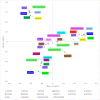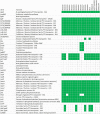Comparative Genomics of Leuconostoc carnosum
- PMID: 33505375
- PMCID: PMC7829361
- DOI: 10.3389/fmicb.2020.605127
Comparative Genomics of Leuconostoc carnosum
Abstract
Leuconostoc carnosum is a known colonizer of meat-related food matrices. It reaches remarkably high loads during the shelf life in packaged meat products and plays a role in spoilage, although preservative effects have been proposed for some strains. In this study, the draft genomes of 17 strains of L. carnosum (i.e., all the strains that have been sequenced so far) were compared to decipher their metabolic and functional potential and to determine their role in food transformations. Genome comparison and pathway reconstruction indicated that L. carnosum is a compact group of closely related heterofermentative bacteria sharing most of the metabolic features. Adaptation to a nitrogen-rich environment, such as meat, is evidenced by 23 peptidase genes identified in the core genome and by the autotrophy for nitrogen compounds including several amino acids, vitamins, and cofactors. Genes encoding the decarboxylases yielding biogenic amines were not present. All the strains harbored 1-4 of 32 different plasmids, bearing functions associated to proteins hydrolysis, transport of amino acids and oligopeptides, exopolysaccharides, and various resistances (e.g., to environmental stresses, bacteriophages, and heavy metals). Functions associated to bacteriocin synthesis, secretion, and immunity were also found in plasmids. While genes for lactococcin were found in most plasmids, only three harbored the genes for leucocin B, a class IIa antilisterial bacteriocin. Determinants of antibiotic resistances were absent in both plasmids and chromosomes.
Keywords: Leuconostoc carnosum; bacteriocin; genomics; metabolism; pangenome analysis.
Copyright © 2021 Candeliere, Raimondi, Spampinato, Tay, Amaretti, Schlundt and Rossi.
Conflict of interest statement
The authors declare that the research was conducted in the absence of any commercial or financial relationships that could be construed as a potential conflict of interest.
Figures





Similar articles
-
Genetic characterization and expression of leucocin B, a class IId bacteriocin from Leuconostoc carnosum 4010.Res Microbiol. 2015 Jul-Aug;166(6):494-503. doi: 10.1016/j.resmic.2015.04.003. Epub 2015 May 6. Res Microbiol. 2015. PMID: 25957244
-
Genetic characterisation and heterologous expression of leucocin C, a class IIa bacteriocin from Leuconostoc carnosum 4010.Appl Microbiol Biotechnol. 2013 Apr;97(8):3509-18. doi: 10.1007/s00253-012-4406-4. Epub 2012 Oct 9. Appl Microbiol Biotechnol. 2013. PMID: 23053070
-
Phenotypic Traits and Immunomodulatory Properties of Leuconostoc carnosum Isolated From Meat Products.Front Microbiol. 2021 Aug 25;12:730827. doi: 10.3389/fmicb.2021.730827. eCollection 2021. Front Microbiol. 2021. PMID: 34512608 Free PMC article.
-
Bacteriocins of leuconostocs isolated from meat.Int J Food Microbiol. 1994 Dec;24(1-2):75-81. doi: 10.1016/0168-1605(94)90107-4. Int J Food Microbiol. 1994. PMID: 7703031 Review.
-
Bacteriocins produced by Leuconostoc species.J Dairy Sci. 1994 Sep;77(9):2718-24. doi: 10.3168/jds.S0022-0302(94)77214-3. J Dairy Sci. 1994. PMID: 7814741 Review.
Cited by
-
Phylogenomic analysis of the genus Leuconostoc.Front Microbiol. 2022 Jul 25;13:897656. doi: 10.3389/fmicb.2022.897656. eCollection 2022. Front Microbiol. 2022. PMID: 35958134 Free PMC article.
-
Comparative genomics of Loigolactobacillus coryniformis with an emphasis on L. coryniformis strain FOL-19 isolated from cheese.Comput Struct Biotechnol J. 2023 Oct 14;21:5111-5124. doi: 10.1016/j.csbj.2023.10.004. eCollection 2023. Comput Struct Biotechnol J. 2023. PMID: 37920811 Free PMC article.
-
Comparative Genomics of Lentilactobacillus parabuchneri isolated from dairy, KEM complex, Makgeolli, and Saliva Microbiomes.BMC Genomics. 2022 Dec 5;23(1):803. doi: 10.1186/s12864-022-09053-y. BMC Genomics. 2022. PMID: 36471243 Free PMC article.
-
Comparative genomics of Leuconostoc lactis strains isolated from human gastrointestinal system and fermented foods microbiomes.BMC Genom Data. 2022 Aug 2;23(1):61. doi: 10.1186/s12863-022-01074-6. BMC Genom Data. 2022. PMID: 35918643 Free PMC article.
-
Characterization of Leuconostoc carnosum and Latilactobacillus sakei during Cooked Pork Ham Processing.Foods. 2023 Jun 24;12(13):2475. doi: 10.3390/foods12132475. Foods. 2023. PMID: 37444213 Free PMC article.
References
-
- Budde B. B., Hornbaek T., Jacobsen T., Barkholt V., Koch A. G. (2003). Leuconostoc carnosum 4010 has the potential for use as a protective culture for vacuum-packed meats: culture isolation, bacteriocin identification, and meat application experiments. Int. J. Food Microbiol. 83 171–184. 10.1016/S0168-1605(02)00364-1 - DOI - PubMed
LinkOut - more resources
Full Text Sources
Other Literature Sources
Molecular Biology Databases

